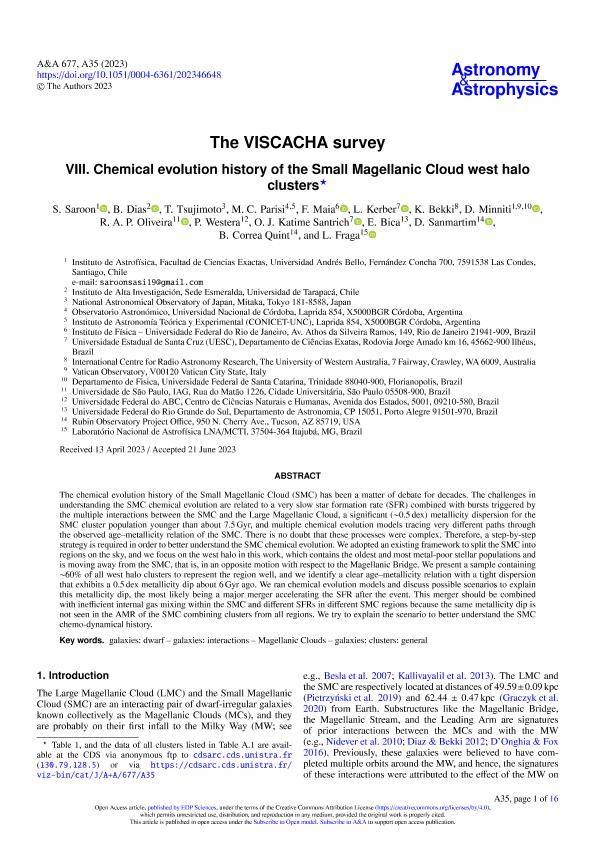Mostrar el registro sencillo del ítem
dc.contributor.author
Saroon, S.
dc.contributor.author
Dias, B.
dc.contributor.author
Tsujimoto, T.
dc.contributor.author
Parisi, Maria Celeste

dc.contributor.author
Maia, F.
dc.contributor.author
Kerber, L.
dc.contributor.author
Bekki, K.
dc.contributor.author
Minniti, D.
dc.contributor.author
Oliveira, R. A. P.
dc.contributor.author
Westera, P.
dc.contributor.author
Katime Santrich, O. J.
dc.contributor.author
Bica, E.
dc.contributor.author
Sanmartim, D.
dc.contributor.author
Correa Quint, B.
dc.contributor.author
Fraga, L.
dc.date.available
2024-03-26T15:06:50Z
dc.date.issued
2023-09
dc.identifier.citation
Saroon, S.; Dias, B.; Tsujimoto, T.; Parisi, Maria Celeste; Maia, F.; et al.; The VISCACHA survey. VIII. Chemical evolution history of the Small Magellanic Cloud west halo clusters; EDP Sciences; Astronomy and Astrophysics; 677; 9-2023
dc.identifier.issn
1432-0746
dc.identifier.uri
http://hdl.handle.net/11336/231603
dc.description.abstract
The chemical evolution history of the Small Magellanic Cloud (SMC) has been a matter of debate for decades. The challenges in understanding the SMC chemical evolution are related to a very slow star formation rate (SFR) combined with bursts triggered by the multiple interactions between the SMC and the Large Magellanic Cloud, a significant (∼0.5 dex) metallicity dispersion for the SMC cluster population younger than about 7.5 Gyr, and multiple chemical evolution models tracing very different paths through the observed age–metallicity relation of the SMC. There is no doubt that these processes were complex. Therefore, a step-by-step strategy is required in order to better understand the SMC chemical evolution. We adopted an existing framework to split the SMC intoregions on the sky, and we focus on the west halo in this work, which contains the oldest and most metal-poor stellar populations and is moving away from the SMC, that is, in an opposite motion with respect to the Magellanic Bridge. We present a sample containing ∼60% of all west halo clusters to represent the region well, and we identify a clear age–metallicity relation with a tight dispersionthat exhibits a 0.5 dex metallicity dip about 6 Gyr ago. We ran chemical evolution models and discuss possible scenarios to explain this metallicity dip, the most likely being a major merger accelerating the SFR after the event. This merger should be combined with inefficient internal gas mixing within the SMC and different SFRs in different SMC regions because the same metallicity dip is not seen in the AMR of the SMC combining clusters from all regions. We try to explain the scenario to better understand the SMC chemo-dynamical history.
dc.format
application/pdf
dc.language.iso
eng
dc.publisher
EDP Sciences

dc.rights
info:eu-repo/semantics/openAccess
dc.rights.uri
https://creativecommons.org/licenses/by-nc-sa/2.5/ar/
dc.subject
GALAXIES: DWARF
dc.subject
GALACIES: INTERACTIONS
dc.subject
MAGELLANIC CLOUDS
dc.subject
GALAXIES: CLUSTERS: GENERAL
dc.subject.classification
Astronomía

dc.subject.classification
Ciencias Físicas

dc.subject.classification
CIENCIAS NATURALES Y EXACTAS

dc.title
The VISCACHA survey. VIII. Chemical evolution history of the Small Magellanic Cloud west halo clusters
dc.type
info:eu-repo/semantics/article
dc.type
info:ar-repo/semantics/artículo
dc.type
info:eu-repo/semantics/publishedVersion
dc.date.updated
2024-02-06T13:28:12Z
dc.journal.volume
677
dc.journal.pais
Reino Unido

dc.journal.ciudad
Londres
dc.description.fil
Fil: Saroon, S.. Universidad Andrés Bello; Chile
dc.description.fil
Fil: Dias, B.. Universidad de Tarapacá; Chile
dc.description.fil
Fil: Tsujimoto, T.. National Astronomical Observatory Of Japan; Japón
dc.description.fil
Fil: Parisi, Maria Celeste. Consejo Nacional de Investigaciones Científicas y Técnicas. Centro Científico Tecnológico Conicet - Córdoba. Instituto de Astronomía Teórica y Experimental. Universidad Nacional de Córdoba. Observatorio Astronómico de Córdoba. Instituto de Astronomía Teórica y Experimental; Argentina
dc.description.fil
Fil: Maia, F.. Universidade Federal do Rio de Janeiro; Brasil
dc.description.fil
Fil: Kerber, L.. Universidade Estadual de Santa Cruz; Brasil
dc.description.fil
Fil: Bekki, K.. University of Western Australia; Australia
dc.description.fil
Fil: Minniti, D.. Universidad Andrés Bello; Chile
dc.description.fil
Fil: Oliveira, R. A. P.. Universidade de Sao Paulo; Brasil
dc.description.fil
Fil: Westera, P.. Universidad Federal Do Abc; Brasil
dc.description.fil
Fil: Katime Santrich, O. J.. Universidade Estadual de Santa Cruz; Brasil
dc.description.fil
Fil: Bica, E.. Universidade Federal do Rio Grande do Sul; Brasil
dc.description.fil
Fil: Sanmartim, D.. Rubin Observatory Project Office; Estados Unidos
dc.description.fil
Fil: Correa Quint, B.. Rubin Observatory Project Office; Estados Unidos
dc.description.fil
Fil: Fraga, L.. Laboratório Nacional de Astrofísica; Brasil
dc.journal.title
Astronomy and Astrophysics

dc.relation.alternativeid
info:eu-repo/semantics/altIdentifier/url/https://www.aanda.org/articles/aa/full_html/2023/09/aa46648-23/aa46648-23.html
dc.relation.alternativeid
info:eu-repo/semantics/altIdentifier/doi/http://dx.doi.org/10.1051/0004-6361/202346648
Archivos asociados
